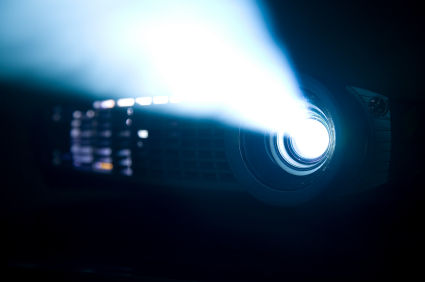 We have to admit, we got a little giddy when we got an email from Jason asking us to go over the various technology options available for front projector home theaters. With rear projection television fading into the sunset, we don’t often get the opportunity to talk about the various merits of LCD, DLP, and LCoS projection technologies anymore. It’ll be like the good old days.
We have to admit, we got a little giddy when we got an email from Jason asking us to go over the various technology options available for front projector home theaters. With rear projection television fading into the sunset, we don’t often get the opportunity to talk about the various merits of LCD, DLP, and LCoS projection technologies anymore. It’ll be like the good old days.
Today’s Show:
News:
- Analog HD from Blu-ray isn’t going anywhere
- HD Netflix Streaming on PC Coming This Year?
- Blockbuster On Demand coming to Connected Samsung HDTVs…
- LED-Backlit Models to See Major Growth, Reaching 20% of LCD TVs This Year
Other:
- Zarban.com, The House of Commentaries
- Lanyardlab.com – Custom lanyards made in 4-7 days
- Sound&Vision 2009 Editors Choice Awards
Front Projector Technologies
We have to admit, we got a little giddy when we got an email from Jason asking us to go over the various technology options available for front projector home theaters. With rear projection television fading into the sunset, we don’t often get the opportunity to talk about the various merits of LCD, DLP, and LCoS projection technologies anymore. It’ll be like the good old days.
We’ve seen many technologies come and go since Episode 1 of the podcast. We’ve had a great time over the years explaining and analyzing the pros and cons of CRT displays, LCD projection, DLP TVs and even a brief love affair with LCoS technology. Anyone remember Brillian? Although it seems everything is flat panel these days, many of these technologies live on as front projectors.
LCD
The earliest digital projectors were based on Liquid Crystal Display (LCD) technology. We have podcast episodes in the archives all about it, but most of them were lost in the transition to our new website. Bottom line, LCD is a tried and true technology. It typically has very vibrant color and provide a very sharp, crisp picture.
On the downside, LCD’s vibrant color and crisp picture tends to produce video that doesn’t looks quite as real or lifelike as other technologies. Many describe it as looking more digital. It also doesn’t have the contrast capabilities of the other technologies, which is critical to home theater applications. For the office, LCD is great, for the home theater, it hasn’t quite won the hearts and minds of the masses.
DLP
Digital Light Projection (DLP) is a Texas Instruments invention that uses millions of tiny mirrors to reflect the light your see onscreen. Historically, it has been one of the more controversial and debated technologies on the show. When you’re feeling nostalgic, go ahead and do a Google search for wobulation. ; That’ll bring back some memories.
On the upside, DLP produces better contrast and black levels than LCD. This makes it ideal for home theater applications. On the downside, it isn’t quite as sharp as LCD and has suffered from all sorts of crazy screen artifacts like rainbows, silk screen effect and others. Ara has two DLP rear projection sets that he is quite fond of.
LCoS
Liquid Crystal on Silicon (LCoS) comes in several variants. JVC markets it as D-ILA; Sony markets it as SXRD. LCoS uses liquid crystals like LCD, but they are reflective (almost like mirrors) instead of transmissive. At a really high level, the technology almost feels like the perfect marriage of the other two.
Of the projectors we’ve seen and used, the LCoS models tend to come out on top. They produce a great, vivid picture and excellent contrast ratios. We were big fans of SXRD and D-ILA rear projection TVs (Braden owns a JVC) when they were out, and have always been impressed with their front projector variants as well. Early on DLP had an edge in contrast ratios, but that no longer holds true.
Of course, LCoS doesn’t come without a price. The Sony and JVC projectors tend to be more expensive than their DLP or LCD competition, with JVC edging Sony slightly in the bang for your buck department.
Conclusion
Bottom line, LCD projectors are bright, vivid and inexpensive. DLP projectors are darker, provide better contrast and don’t cost as much. LCoS projectors probably give the best picture, but they cost a lot. You have to weigh the pros and cons for yourself and see what your budget will allow. In the end, though, no matter what you choose, there’s no denying that a 120″ screen is pretty darn cool.





